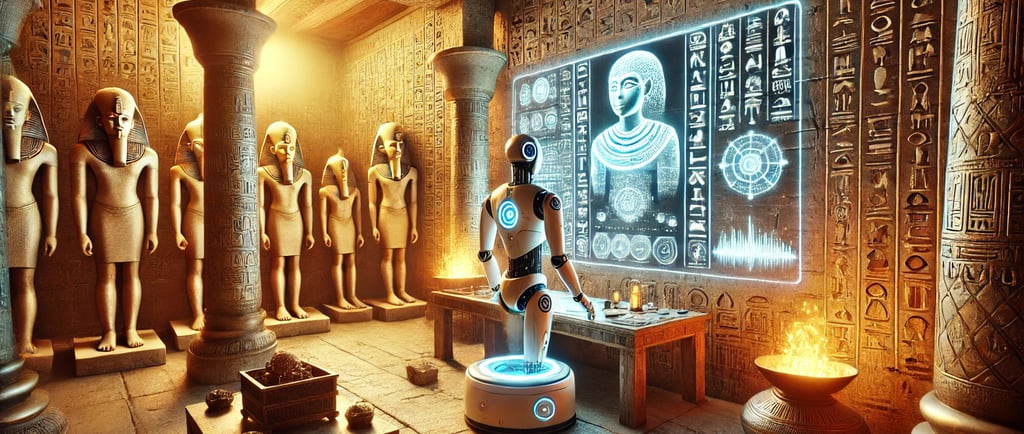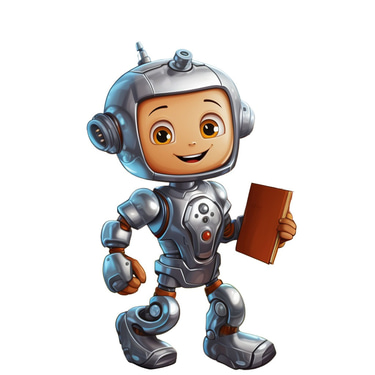AI and Mysteries: How AI Could Help Solve Ancient Mysteries and Puzzles
7/3/20244 min read


Introduction to AI and Ancient Mysteries
Artificial Intelligence (AI) has undergone a remarkable transformation since its inception. Initially conceptualized as a theoretical framework in the mid-20th century, AI has evolved into a sophisticated technology capable of performing tasks that once required human intelligence. From early rule-based systems to advanced machine learning algorithms, AI's journey has been marked by significant milestones. Today, AI encompasses various subfields, including natural language processing, computer vision, and neural networks, each contributing to its impressive analytical and predictive capabilities.
The realm of ancient mysteries presents a fascinating juxtaposition to modern technology. These mysteries, often rooted in the distant past, include enigmatic artifacts, unexplained structures, and undeciphered scripts. Famous examples include the Phaistos Disc, the Voynich Manuscript, and the construction of the Great Pyramids. These puzzles have intrigued scholars and enthusiasts for centuries, primarily because traditional methods of investigation have yielded limited results.
AI's potential in addressing these ancient enigmas lies in its ability to process and analyze vast amounts of data far more efficiently than human researchers. By leveraging pattern recognition, AI can identify correlations and anomalies that might elude human perception. For instance, AI algorithms can be employed to decode ancient languages by recognizing recurring patterns and linguistic structures within undeciphered texts. Similarly, computer vision techniques can analyze and reconstruct ancient artifacts, providing insights into their origins and purposes.
Moreover, AI's predictive capabilities allow for the formulation of hypotheses that can be empirically tested. For example, machine learning models can simulate various construction techniques to determine the most plausible methods used in ancient engineering marvels. By drawing parallels between the analytical prowess of AI and the complexities of ancient mysteries, it becomes evident that AI can serve as a powerful tool in unveiling the secrets of our past.
As we delve deeper into the application of AI in solving ancient mysteries, it is essential to recognize the interdisciplinary nature of this endeavor. Combining historical knowledge with cutting-edge technology paves the way for groundbreaking discoveries, ultimately enriching our understanding of ancient civilizations and their legacies.
AI Techniques in Deciphering Ancient Scripts and Languages
The field of deciphering ancient scripts and languages has been significantly enhanced by the advent of artificial intelligence (AI). Machine learning algorithms, pattern recognition, and natural language processing (NLP) tools have emerged as powerful instruments in the analysis and interpretation of ancient texts. These AI techniques offer new ways to tackle the complexities and intricacies of languages that have long eluded historians and archaeologists.
Machine learning algorithms, for instance, can be trained to recognize patterns in undeciphered scripts by analyzing large datasets of known languages. Through supervised learning, these algorithms can identify similarities and differences, thereby making educated guesses about the meaning of unknown symbols. One notable application of machine learning is the study of the Dead Sea Scrolls. Researchers have employed AI to piece together fragments of these ancient manuscripts, uncovering new insights into their historical and religious significance.
Pattern recognition is another crucial AI technique in this domain. By identifying recurring symbols and structures within ancient texts, AI can assist in decoding scripts that have remained mysterious for centuries. The Rosetta Stone, which played a pivotal role in understanding Egyptian hieroglyphs, serves as a prime example. Although the Rosetta Stone was deciphered without AI, modern techniques could further refine our understanding and potentially uncover additional layers of meaning.
Natural language processing (NLP) tools also play a vital role in the deciphering process. NLP can analyze the syntax and semantics of ancient languages, comparing them with contemporary languages to find potential correlations. This approach has been used to study Linear B, an ancient script used by the Mycenaean civilization, leading to significant breakthroughs in understanding their language and culture.
Despite these advancements, challenges persist. Incomplete data and the need for high computational power remain significant hurdles. Many ancient texts are fragmented or eroded, making it difficult for AI to analyze them comprehensively. Additionally, the computational power required to process large datasets and run complex algorithms can be substantial. However, ongoing advancements in AI technology, such as quantum computing, hold promise for overcoming these obstacles, potentially unlocking further secrets of our past.
Reconstructing Lost Civilizations and Artifacts with AI
Artificial Intelligence (AI) is revolutionizing the field of archaeology by providing innovative methods to reconstruct lost civilizations and artifacts. This technology offers a virtual glimpse into the past, enabling researchers to piece together historical puzzles with unprecedented accuracy. Machine learning models, a subset of AI, are particularly effective in predicting the locations of hidden artifacts or ancient structures. By analyzing vast amounts of data, including satellite images and historical records, these models can identify potential excavation sites, significantly reducing the time and resources required for archaeological digs.
One of the most compelling applications of AI in archaeology is the use of AI-driven 3D modeling and virtual reality (VR) technologies. These tools can recreate ancient cities, structures, and artifacts in stunning detail, allowing both researchers and the public to interact with history in an immersive way. For instance, AI algorithms can analyze fragments of ancient pottery or architecture to generate complete 3D models, providing insights into the original form and function of these objects. Such reconstructions are invaluable for studying the cultural and technological advancements of lost civilizations.
Several case studies highlight the transformative impact of AI in this area. For example, the famous city of Pompeii, which was buried under volcanic ash in 79 AD, has been partially reconstructed using AI-based techniques. Machine learning algorithms analyzed the city's ruins and generated detailed 3D models, offering a clearer picture of daily life in ancient Pompeii. Another notable project is the restoration of the ancient city of Palmyra in Syria, which has been severely damaged in recent conflicts. AI-driven 3D modeling has been instrumental in virtually restoring its iconic structures, preserving cultural heritage for future generations.
In essence, AI serves as a powerful tool in the quest to uncover and preserve the secrets of bygone eras. By leveraging advanced technologies, we can not only enhance our understanding of ancient civilizations but also ensure that their stories continue to inspire and educate long into the future.
